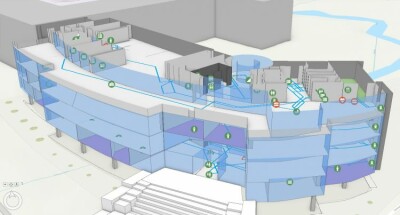ArcGIS Enterprise on Kubernetes
The most surprising news for this year’s Esri DevSummit was the announcement that ArcGIS Enterprise can now be deployed through Kubernetes, an open-source platform for automating the deployment and scaling of containerized applications. ArcGIS Enterprise is a way to implement comprehensive GIS inside the infrastructure of an organization. It provides GIS, powering mapping and visualization, analytics, and data management functionality, which is available through apps and extensions. The next version of ArcGIS Enterprise, scheduled for May 2021, will include a new deployment option for Kubernetes.
This deployment option uses cloud-native architecture and is based on microservices, containers and Kubernetes: microservices provide scalability and resiliency, while containers are used for software delivery, orchestrated through Kubernetes. Large organizations using ArcGIS Enterprise will benefit from this new deployment option as it offers easy upgrades that minimize downtime, streamlined installation and dynamic scaling. It will be initially only available for three Kubernetes engines (Amazon Web Services Elastic Kubernetes Service (EKS), Microsoft Azure Kubernetes Service (AKS), and Red Hat OpenShift), but Esri’s roadmap includes expanding to more engines.
ArcGIS Platform
First announced in January, Esri released ArcGIS Platform, a geospatial platform as a service (PaaS) for developers that need to integrate location capabilities into their apps, business systems, and products. ArcGIS Platform gives developers direct access to Esri’s location services using the APIs and web frameworks of their choice. All tools and accompanying documentation are now available through the ArcGIS Developers website.
SURE for ArcGIS
A new automated reality capture software product named SURE for ArcGIS, processes photogrammetric imagery and lidar data and transforms them into textured meshes, true orthophotos, point clouds and digital surface models that can be used directly into ArcGIS. This product announcement is the result of Esri acquiring nFrames in September 2020 and integrating their SURE software into the ArcGIS product family, that will now enable the fusion of imagery with 3D GIS.
ArcGIS Image for ArcGIS Online
A new SaaS offering that forms part of ArcGIS Online, is ArcGIS Image for imagery management, visualization, and raster analytics. It will be made available generally in Q2 of 2021, after having been in beta since Q4 of 2020. Imagery can be uploaded from a desktop location to ArcGIS Online and from there made available as tiled imagery layers or dynamic imagery layers to other ArcGIS Online users. A new feature, tiled imagery layers, are stored inside ArcGIS Online in a cloud-optimized raster format, with support for all pixel types and depths, and multi-band, multispectral imagery.

Dynamic imagery layers support primarily large image collections that are managed using mosaic datasets. These collections can be mosaicked on the fly. Both imagery layer types support server-side raster functions, that create new layers. This new cloud-based offering also streamlines multiple existing workflows for publishing and serving imagery, as well as a variety of tools to prepare data for publishing and serving imagery.
ArcGIS Pro 2.8
Esri’s desktop application ArcGIS Pro will soon see a new major release with version number 2.8. New functionality was previewed for the first time during the online plenary session of this year’s DevSummit: a new data engineering experience and SAS integration into Pro.
Data Engineering
Data scientists spend a lot of time doing data engineering, which is the process of getting the data ready for analysis. The upcoming 2.8 release of Pro will include a data engineering experience for constructing, formatting, cleaning, and integrating spatial data for analysis. Data Engineering tools can be accessed by right clicking any feature layer that has been added to the contents pane inside Pro and selecting the Data Engineering option. For individual table fields, statistical values such as the minimum, maximum and standard deviation can be calculated. This is already possible with the current version of Pro using the Statistics tool, but the user experience is far from optimal, as there is no overview functionality for comparing the field statistics for multipole fields. Also, the Data Engineering capability introduces a new Data Engineering ribbon tool with added functionality.

SAS-ArcGIS Bridge
Comparable with the existing R-ArcGIS Bridge add-in for ArcGIS Pro that converts R data into GIS data and vice versa, this new tool supports integration with SAS, a statistical software suite with advanced data science capabilities. Two new geoprocessing tools make this possible: a conversion tool for SAS datasets to a feature layer attribute table format and vice versa. Furthermore, the tool lets you run SAS code for analysis procedures within Pro through the SASPy and SWAT python packages that can be accessed through ArcGIS Notebooks inside Pro.






